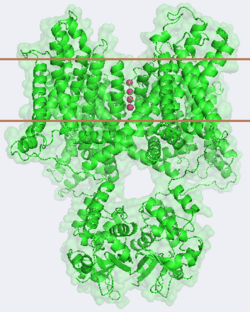Potassium Channels control cell membrane electric potentials by selectively allowing diffusion of K
+ across the membrane.
[1] K
+
The structure is comprised of 4 identical subunits. Each subunit has a and one fourth of the pore.
There is the marked between the parallel lines in the figure. This region houses
the , composed of interwoven helices in a teepee conformation, the all-important , providing the channel with its remarkable 10,00 fold selectivity for K+ ions over Na+ ions and the which is uses well placed arginine and acidic residues to determine the membrane polarity and open/close the channel in response.[2]
See what the The looks like vs. The (1k4c). Or view the morph of the ().
Overall mechanism
The main steps that potassium ions go trough when leaving the cell are:
- Entering the hydrophobic pocket
- Aqueous cavity and desolvation
- Selectivity filter
- Explaining the voltage sensor and closing/opening of channel
Entering the hydrophobic pocket
It is important to notice that with the exception of the selectivity filter, the pore lining is .
The entrance of the channel, at the bottom of the 34Å pore containing transmembrane region lies a number of which help form a seal between the pore and the intracellular cytoplasm. This domain is called the lower gate.
Aqueous cavity and desolvation
This hydrophobic lining provides an inert surface over which the diffusing ion can slide unimpaired, without getting attached anywhere until the aqueous cavity. At the end of the hydrophobic porus there is an (). At this point, K+ ions find a position of hydration and get ready to be dehydrated and get into the selectivity filter.
Selectivity Filter and Pore
At this point it is clear to see where the channels remarkable selectivity comes from.
When entering the , K+ ions are first dehydrated, shedding up to 8 waters of the .
Another factor that drives the cations leave the aqueous cavity and enter the selectivity filter is the , with the
Why K+ and not Na+
To stabilize these naked ions, () bind the K+ ions. The distance between K+ ion and carbonyl oxygen is at to accommodate K+ ions but not Na+, ions which are too small. If a Na+ ion were to lose its water shell, the carbonyl oxygens could not successfully stabilize it in its naked form and thus it is energetically unfavorable for a Na+ ion to enter the channel.
Knock-on mechanism
There is room within the selectivity filter for . This, as it turns out, is crucial as the presence of the positive cations in close proximity to one another effectively pushes the potassium ions through the filter via electrostatic forces (the knock-on mechanism). This helps explain how the potassium channel can have such a rapid turnover rate. Compared to the (1k4c), when exposed to a low concentration of potassium, the channel assumes a (1k4d) which is sealed shut via interactions with water molecules.[1]
Physical gating: The Voltage Sensor Domain (VSD)
Channel pore opening is dependent on the membrane voltage, a characteristic that is “sensed” by the .
The voltage sensor is comprised of , S0, S1, S2, S3, S4, & S5. Negatively charged sensor residues are either located in the , consisting of Glu 183 (in the 2r9r structure) and Glu 226, or in the consisting of Glu 154, Glu 236, and Asp 259. The external cluster is exposed to solvent while the internal cluster is buried. acts as a separator between the two clusters.[2] The 7 of the voltage sensor are located on the S4 helix. Lys 302 and Arg 305 with the internal negative cluster while Arginines 287, 290, 293, 296 and 299 are (). When the voltage sensor is exposed to a strong negative electric field in the intracellular membrane, the positive gating charges shift inward with the α-carbon of Arg 290 coming in close proximity to Phe 233. This shift effectively squeezes the pore shut, closing the intracellular-extracellular pathway. For a comparison see: The Channel vs. The (1k4c) Channel.[2] Or view the morph of the ().
Hydrophobic gating: Dewetting
After the channel is physically closed, there is a short period time during which there is still current (ions being pumped).
It is not until the waters leave the hydrophobic pocket that ions cannot be stabilized in the hydrophobic part of the pore and therefore not being brought to the selectivity filter.
This is called hydrophobic gating, meaning that the gating process is not necessarily mechanical but also chemical.

